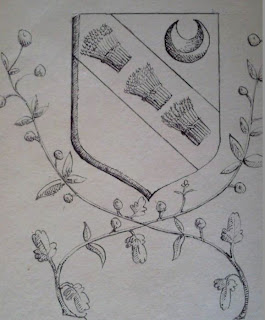He wanted a commonplace book, a book of sorts, it may contain prayers, notes, accounts, recipes, basically anything of use or potentially of use to the owner.
The soft binding seems common enough, certainly the binding in this case is strongly based on the Greenhaulgh account book, Greenhaulgh was a Bailiff to a local landowner in the middle of the 15th century and his account book survives. This style of book appears to have been used for sketch books also. It makes economic sense, you have a soft binding which can be done cheaply ad easily at home, you add in the sections as required and if you need it hard bound at some point then you can, if not then no cost incurred on the binding.
The Greenhaulgh book shows evidence of expansion inasmuch as there are two distinct sets of binding thread, one blue and one white, they also are at different heights on the spine, suggesting a possible update at a later time.
What the book below does not have what the Greenhaulgh book does is a late 14thc music sheet pasted into the wrapper to provide stiffness, that alone in the original is interesting as it still has the clear remains of the azurite or ultramarine lettering and vermillion/red lead rubrics.
I do not have permission to show the book so you will have to bear with me.
Back to the client's book.
The client had a clear idea of the contents:
A device drawn into the front page, his device being three sheaves of corn with a bend and a crescent - forgive me I do not know the heraldic form for that. I added the floral arrangement, this was based on a late 15th design with just such an escutcheon within it.
A list of ordinance, cannons.
Some metal point drawings of ordinance
A tract on fencing, early 15thc
Some useful recipes, including a corrosive liquid to clean wounds, very useful for a soldier I imagine.
The book itself is calf leather, approx 1mm, I dyed it with brazil wood.
Brazil is a dye yielding tree from the caesalpina family the name predates the country by some hundreds of years. It would appear that the discovery of similar colour yielding trees in Latin America in the early 16thc gave rise to the name of the country. The Caesalpina of the medieval world was C. sappanensis, and that of the New was C. Echinata. It would appear that most of the Brazil wood today does indeed come from Brazil. For the purposes of my work that is fine as the colour yield appears to be the same. If at such time I acquire C. Sappanensis I will conduct some trials for comparison.
The dye was prepared as per medieval recipes, the wood was shaved small and soaked in water, an amount of alum was added to the bath and boiled until the water was as red as it was going to be, allowed to settle and strained off.
In this case the leather was dyed both sides, some historic mentions say to only apply dye to the visible surface, in one particular case, the uppers of shoes, again a sensible economy, why dye the inside of something that will not be seen and most likely be corrupted by sweat?
Finally, as with all my medieval and Tudor paperwork I only use GriffenMill archive papers, these have been especially made to resemble early laid papers and they are a joy to use.
The ink is oak gall and the pens used goose quill, standard materials and tools for me.



1 comment:
Beautiful work!
Post a Comment